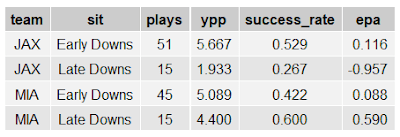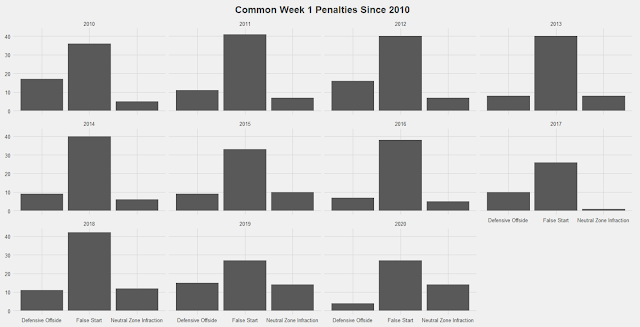With that being said, the Jaguars torrid offensive start came with a large red flag, one that made me question their status as a three point favorite in last night's contest: their third down performance. Third down and fourth down performance is not an especially sticky measure, even in the realm of football analysis. The issue is multi-faceted. Play-calling is wildly different in these late downs situations because the scope of the play is changed. Instead of being able to sequence a play with another play or try to fool the defense and take a shot down the field, on late downs the goal is often just to move the sticks. Obviously on first and second down (the early downs) the offense still has the goal of another first down in mind, but the immediacy of needing that first down is totally different. Late down plays are more predictable because the goal of the offense on that play is much more clear to the defense. On early downs, for all the defense knows, the offense just cares about gaining a few yards on a run up the middle or it wants to catch the secondary sleeping for a chunk passing play. The other reason late down efficiency splits are not meaningful is the leverage. Offensive teams have the potential to add massive expected points totals on third and fourth down because the baseline expected point values are so low in these situations since more often than not the offensive will turn the ball over to the opposition in the form of either a punt or field goal. Since the magnitude of a single late down conversion (i.e. getting a first down and starting a new series) can be so large and late down plays are a smaller portion of the overall play sample for a given team compared to early down plays, late down splits should be regressed heavily towards the means.
We learn a lot more about teams based on how they play on early downs and how well they avoid these high leverage late down situations all together. The year over year consistency in late down performance is mostly noise, to the tune of a correlation coefficient of about 7.6 percent, based on data from 2010 through 2019. For more actionable information to help handicap the Jaguars going into last night's game, I looked at the relationship between a team's late down performance in weeks one and two and compared it to the rest of season late down performance for all team seasons from 2010 through 2019.
The first two week late down performance only explains 3.1 percent of the variance in late down performance for the rest of the season, so effectively it is noise. This is especially important when considering how Jacksonville's offense fared so well in weeks one and two and what that meant for week three and beyond. Even without the context of their early down offense, the Jaguars late down performance against the Titans and Colts was impressive. When you do incorporate that context, their rate of efficiency is even more eye-popping.
The Jaguars, along with the Raiders, stand in a league of their own here. Despite middling early down efficiency figures, the Jaguars were the second best team in EPA per play on late downs. Furthermore through two weeks, the Jaguars ranked first in percent of third downs converted at 62.5 percent (about 50 percent better than league average thus far) and they converted their lone fourth down opportunity, bringing their total late down conversion rate to 64 percent which was still first in the league. This was all while posting middle-of-the-pack figures on early down EPA per play and early down first down rate. This was still better than expected performance for Jacksonville, but the Jaguars top-five offense through two weeks was a house of cards built on late down success. Here are there early and late down splits in weeks one and two compared to their opponents:
Jacksonville, on a per-play basis, was out-gained handily in terms of yards and posted lower efficiencies in terms of success rate (percent of plays that produce positive EPA) and EPA. While the success rates on early downs are relatively close, the Colts and Titans combined posted almost double the expected points per play on offense compared to Jacksonville. On late downs, the margins more than just flipped: the Jaguars added more than three times that amount of expected points per late down play. Their late down EPA play was almost nine times their early down figure.
I am burying the lead here, but this phenomenon completely vanished for the Jaguars against the Dolphins. Despite losing by three scores, the Jaguars were actually more efficient than Miami on early downs. The loss can be chalked-up to a reversal of fortune on late down plays:
Jacksonville posted higher yards per play, success rate, and EPA figures on early downs. On late downs, the Jaguars could not even muster up two yards a play and lost almost an entire point per late down play, compared to Miami who posted figures similar to Jacksonville through week two. This game should have been much closer based on the more stable metrics when evaluating offenses, but Miami was able to get into manageable third downs and convert (based on the Dolphins elite efficiency compared to their low yards per play total). Jacksonville did the opposite and now both teams find themselves at with one win on the season.
If Jacksonville hopes to remain competitive, the early down offense needs to be a tick better. They were never going to sustain their third down performance through two weeks, but something between that and what they did on Thursday needs to be the norm going forward. Given the personnel, middling offensive performance, and horrid defense, I would still say this is a Jacksonville team that is in for a long season. Maybe not a "first overall pick with a bullet" type season, but the Jaguars still have a lot of kinks to iron out before I would even consider them to be a playoff contender.




















